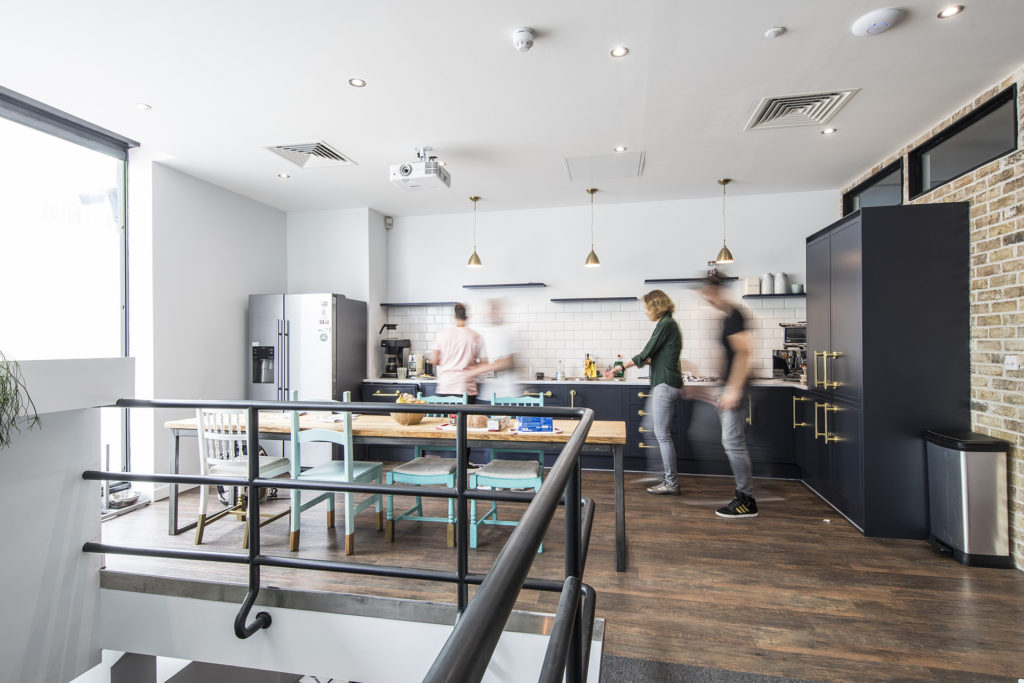With teachers leaving the profession in greater numbers than ever, the issue of staff wellbeing has never been more important. For all schools, teacher retention is crucial, education is in real danger of losing some of its most valuable members of staff.
It’s no secret that working in the classroom is challenging, all those involved recognise the stresses and strains that teachers are facing. Ofsted have even made reference to the wellbeing of school employees in their new framework, stating that they will now be checking measures are properly implemented to avoid the overworking of teachers and support staff.
All of which places a great emphasis on the importance of correctly managing the environment outside of the classroom. With tensions and emotions in the classroom at a heightened state, having somewhere to switch off and disengage from the pressures of teaching is crucial.A well considered staffroom can help to do this. If properly managed, the staffroom can provide a small sanctuary in an otherwise high pressured environment.Environment MattersThe thought that goes into the design and implementation of the staffroom is a clear indication of where staff wellbeing ranks by those in senior management. A small unloved area with uncomfortable seats and a noisy inefficient kettle, sends a message to employees that they aren’t particularly valued by those clutching the purse strings. And whilst the staffroom needn’t be palatial, it should at the very least, be a pleasant place to sit. Time spent here is likely to be brief, so those few stolen moments of peace should be spent in a welcoming environment.
How Will it Be Used?
Deciding on how the staffroom is to be used is a key factor in determining its design. If it’s purely an area for relaxing and taking coffee breaks, than the furniture and facilities should reflect this. If it’s a place that will be used for regular meetings, than this should be accounted for. And if teachers and support staff will be using it as space to work during non-contact time, then the capability to work quietly and efficiently should be offered. As with all spaces in schools, it’s likely that the area will seek to satisfy a variety of uses. In this instance, it’s important to install furniture that is flexible and can be easily adapted to a variety of situations and circumstances.
Must it Look Like a School Staffroom?
Just as the design of the school classroom tends to be stuck in a formulaic rut, so is the layout of the traditional staffroom. Schools the world over have staffrooms housing circles of mismatched chairs, all congregated around a wonky wooden coffee table and a wilting pot plant. Don’t be afraid to break out from the mould. Make the decor inviting, consider interesting seating, and think carefully about the design of the room as a whole package.
Encourage Conversation
Teaching can be a lonely profession. The regular interaction with children often gives the impression of constant engagement, but it’s vital that staff are provided with time, even if briefly, to have meaningful adult conversation. This is where the staffroom is a vital element of a high-functioning school as it can help to reduce isolation and encourage communication between staff. For senior management, it serves as a useful low threat environment to casually keep an eye on the emotional wellbeing of all staff members. Regular interaction between teachers is key in ensuring that information flow is regular and consistent. During a busy day, these informal catch ups between staff members serve as an invaluable opportunity to pass on and discuss important knowledge regarding pupils.
What Happens in Other Workplaces?
If utilised correctly, central spaces in an environment can set the tone and culture of the workspace. Some of the world’s most successful corporations, such as Google and Facebook, pride themselves on being leaders in workplace design, and it’s no coincidence that staff wellbeing rates highly for these companies. Don’t be tempted to order furniture and facilities fromantiquated school supply catalogues. Take pride in the aesthetics and design of each element of the school building.
In Summary
Placing staff wellbeing high on the agenda sends a powerful message to all those involved with the school. By valuing and caring for all employees, teacher retention rates will remain high and productivity and efficiency will be consistently improved. A strong staff moral is radiated beyond the boundary of the school gates, and word will quickly spread about a positive work ethos. This sends out a strong message to prospective applicants for future roles, and ensures the best candidates are applying for vacancies as they arise. Having a well thought out and carefully designed staffroom, with the intention of improving mental state of mind, will go a long way to instilling a culture of happy and healthy teachers.



